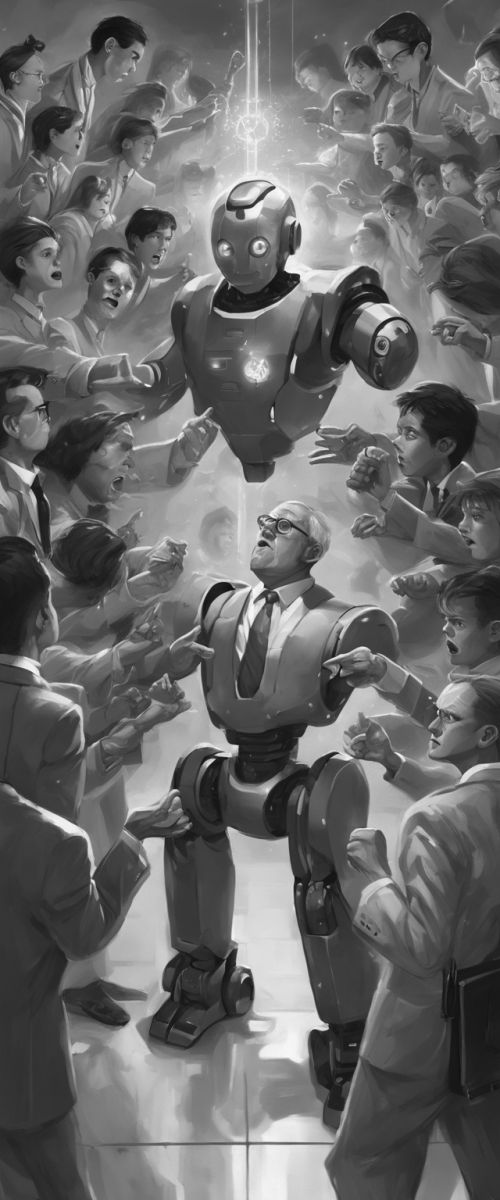The use of artificial intelligence apps like ChatGPT has exploded over the past year, especially in schools. Students and teachers alike have found ways to use AI to assist with lesson plans, explain a topic further, and most commonly, write their essays for them. Universally, teachers and school administrators have struggled to answer what the appropriate use of AI in the classroom looks like. Here is what Garfield thinks:
Teachers on AI
Almost all teachers can tell when a student uses artificial intelligence in their work, whether they use an AI checking tool like Turnitin.com or their intuition. “Teachers kind of have a spidey sense,” as Garfield social studies teacher Jerry Neufeld-Kaiser, often referred to as NK, put it. “I see students submitting writing that is clearly not them, doesn’t sound like a teenager, doesn’t sound like what I’ve seen from that student in the past,” he continued. Other teachers said the same thing. “It’s using vocabulary and styles that a typical teenager doesn’t use,” Jonathan Stever, who teaches science at Garfield, said. He also added that “it takes the personal flavor out of someone’s writing, and I think that is problematic.” Daniel Young, Garfield social studies teacher, also claimed that, “It is easy for me to catch, but if I’m not sure I can run it through a checker.”
AI has a negative connotation to cheating but some teachers think it can have a positive impact in the classroom when used properly. Earl Bergquist, Garfield’s Computer Science teacher, says that “it’s a gift for finding research.” He explained that it can prove to be very useful when searching for things, similar to the Google search engine. Young had similar things to say, stating that “it’s just a more effective way to Google and find quick information.” Young also stated that it could be used “just like a brainstorming partner.” But when used to cheat, it “falls under the plagiarism policy.” He also highlighted how some teachers have begun to use it to help them come up with lesson plans or create questions for assignments. “There is a really nice feature where you can ask it to come up with questions for a YouTube video. So instead of myself watching the YouTube video, I’ll say ‘generate questions for this transcript’, and I’ll selectively go through it.” This can be a big time saver for teachers when doing their lesson planning, allowing them to focus on other things. Young said “within our department, the number is growing, maybe 50% [of teachers] are using it semi-regularly.” So not only can this be a powerful tool for students, but teachers as well.
The teachers who were interviewed are fine with the use of AI as a search engine or research tool. It’s when “people don’t think enough and people depend on it too much,” that it becomes a problem, Stever said. “But you can use it as a supplement as a learning tool.” Stever explained “we’ve used it in assignments to help students who are ELL or special ed students taking a high-level difficult concept reading and making it more accessible.” This use of AI could be expanded in many different areas to help students have the tools they need to learn. Similar thoughts were shared by Bergquist, who stated, “critical thinking is usually the thing that we’re trying to strive for, and I think ultimately we want to find ways that allow students to use those tools but also impart on them that they need to think critically.”
Students on AI
As a student, using AI can be tempting, especially as it becomes increasingly accessible. Snapchat and Instagram have recently added AI features to their app, which makes using artificial intelligence as easy as talking to a friend. One student even described Snapchat AI as their “best friend.” Commonly used platforms by students were Snapchat and ChatGPT and most kids turn to them out of convenience and lack of motivation to do their work. One student explained they were “running out of time and I just was really tired and really did not feel like trying …it was just quick and easy,” and that she “had to use it in a poem because [she] was lacking creativity and [she] knew [her] AI would spice it up.” However, some kids have found a way to use AI that is more productive for their work. “Sometimes if we’re reading a specific book for a class, I’ll ask it the main themes of the book, or if I’m working on a topic idea, I’ll ask for specific examples from texts because it kind of helps with narrowing down sections of the book that are especially important,” another student said. When asked if she thought using AI was cheating the same student said, “I think if you incorporate it with your own ideas,” and you “use it for inspiration,” it’s not. “So as long as you make it your own work, because I’m still putting an effort into these assignments.”
As teachers start to use more AI-detecting technology, students have become more savvy with their AI use. “Well, what I did was I didn’t ask it to write a specific poem because I knew that it would be easy to decipher, AI versus me,” one student said. “I just asked it little questions and just kind of took inspiration from what it said.” Students often give the AI prompts that are specifically designed to make it sound like them and not a robot.
Students can understand why teachers don’t like them using AI but don’t always agree with the reasons. “they want everything to be your idea, but the truth is, nothing is really your idea… Everything’s kind of out there already, and there’s only like so many takes you can do for an essay,” as one student put it. As AI becomes more advanced and accessible, students agree that everyone is going to have to adapt to it, and “teachers will kind of have to grow accustomed to it and learn how to fit it into their teaching style.” As the world changes and more technological advancements emerge there is a decision that has to be made by teachers and school administrators, shun these new methods or use them to further advance student engagement in their learning.






